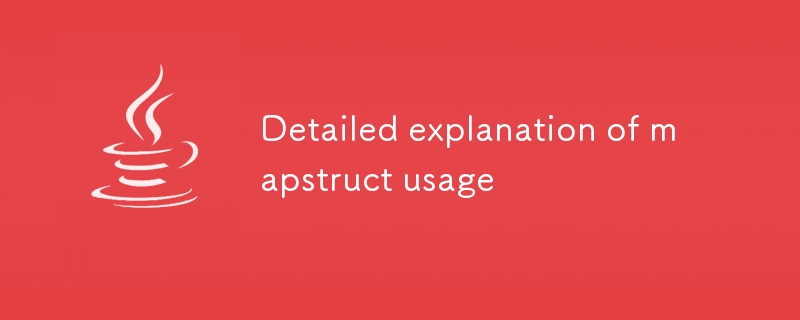mapstruct 사용법에 대한 자세한 설명
- DDD원래의
- 2024-08-15 13:49:23446검색
MapStruct is an annotation-based Java mapping tool that automates object mapping, reducing manual effort and errors. It streamlines the mapping process by using annotations to define mapping rules, providing both simplicity and performance advantages

How to leverage annotations to automate object mapping with MapStruct?
MapStruct is a Java annotation processing tool that simplifies the process of mapping objects from one class to another. It uses annotations to define the mapping rules, and then generates the mapping code at compile time. This eliminates the need to manually write the mapping code, which can be time-consuming and error-prone.
To use MapStruct, you first need to define a mapping interface. The mapping interface defines the methods that will be used to map objects. The methods are annotated with @Mapping annotations, which specify the mapping rules.
For example, the following mapping interface maps a Customer object to a CustomerDTO object:
<code class="java">@Mapping(source = "id", target = "customerId")
@Mapping(source = "name", target = "customerName")
interface CustomerMapper {
CustomerDTO toDto(Customer customer);
}</code>
Once you have defined the mapping interface, you can use it to map objects. To map an object, you simply call the corresponding method on the mapping interface. For example, the following code maps a Customer object to a CustomerDTO object:
<code class="java">Customer customer = new Customer();
customer.setId(1L);
customer.setName("John Doe");
CustomerDTO customerDTO = customerMapper.toDto(customer);</code>
The generated mapping code will handle the mapping of the fields between the Customer object and the CustomerDTO object.
What are the advantages of using MapStruct over other mapping libraries?
MapStruct has several advantages over other mapping libraries, including:
- Simplicity: MapStruct is easy to use. It uses annotations to define the mapping rules, and then generates the mapping code at compile time. This eliminates the need to manually write the mapping code, which can be time-consuming and error-prone.
- Performance: MapStruct is fast. The generated mapping code is highly optimized, and it can map objects much faster than other mapping libraries.
- Extensibility: MapStruct is extensible. You can customize the generated mapping code to meet your specific business requirements. This allows you to use MapStruct to map objects in a way that is tailored to your specific application.
How can I customize MapStruct mappings to meet specific business requirements?
You can customize MapStruct mappings to meet specific business requirements by using the following techniques:
- Using custom converters: Custom converters allow you to specify how specific fields are mapped. This is useful when you need to map fields in a way that is not supported by the default mapping rules.
- Using mapping configuration files: Mapping configuration files allow you to specify global mapping rules that apply to all mappings. This is useful when you need to configure mappings for a specific project or application.
- Extending the MapStruct compiler: You can extend the MapStruct compiler to add new features and functionality. This is useful when you need to customize MapStruct to meet the specific requirements of your project or application.
위 내용은 mapstruct 사용법에 대한 자세한 설명의 상세 내용입니다. 자세한 내용은 PHP 중국어 웹사이트의 기타 관련 기사를 참조하세요!

